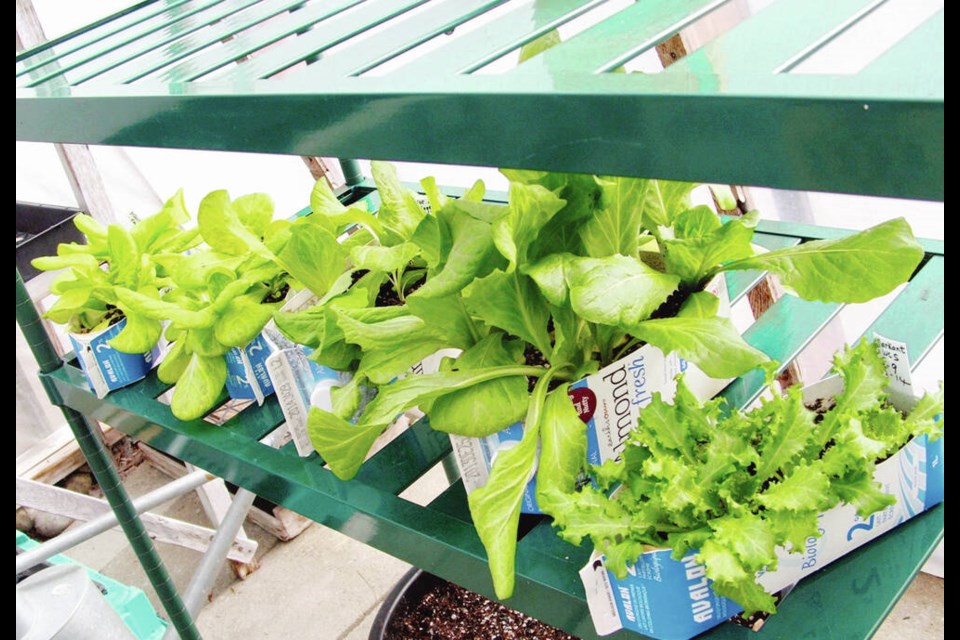Dear Helen: As the seeds I’ve sown indoors begin to germinate, I’m concerned about a problem I’ve had in the past with seedlings stretching out to become weak and spindly. Is there a way to encourage more strong, stocky growth and a better transplant quality?
S.P.
Though most seeds sown indoors germinate best in warmth, once those seeds have sprouted the containers need to be moved to cool room temperatures, which will help to promote sturdy growth. Significant warmth weakens seedlings.
The other common issues that cause seedlings to grow weak and lanky are inadequate light, too much water, and overcrowding.
On the road to becoming transplants, seedlings require bright light short of direct, hot sun. It is best to keep the growing medium just a little on the dry side. I water the medium well at seeding time, but I water after than only when the medium surface begins to dry.
Once seedlings are substantial enough to handle, they need to be either transplanted or thinned. To save labour in the production of the numerous indoor seedings I make, I sow into pots or flats deep (around nine cm) enough to accommodate the seedlings through to transplant size.
Because the seedlings will be staying in the same flat, I use a sterilized, all-purpose potting mix. I sow sparingly, and when the seedlings are substantial enough to handle easily, I thin them out, to give each one adequate room to plump out nicely.
People who still adhere to a two-step indoor sowing practice start the seeds in shallow flats, using an inert, sterile seeding mix. As the seedlings size up they are transplanted into deeper containers with a more substantial growing medium like the one I start out with.
Dear Helen: At this time in the year I always scan through my favourite gardening books for reminders and tips. One of these references warns against putting lime on lawns. For several decades I’ve religiously limed my mossy lawn, in both spring and fall, believing it to be a useful practice. What is your opinion?
D.L.
I agree with you that liming benefits lawns and plantings that do not do well in acidic soils.
A key feature of our west coast climate is plentiful rainfall from mid-autumn through early spring. That rain tends to wash water-soluble elements through the soil. Most readily leached out are alkaline elements, including calcium, magnesium and potassium. The process leaves soils in varying degrees of acidity.
The loss of these elements is most pronounced in sandy soils, because these open-textured soils allow water to pass through rapidly, carrying alkaline minerals with them.
The leaching begins with the fall rains and continues through the winter. Applying lime in the fall makes sense. That lime helps to replenish the soil with calcium (and magnesium if dolomite lime is used) as those elements are being leached out of the soil. Depending on the degree of acidity in the soil, an additional application of lime may be needed in the spring.
Dear Helen: When should fig trees be pruned? Is it a complex procedure?
P.C.
Not really. This year’s figs will develop on the youngest, one-year old growth, that is wood that was produced last year.
Take out all the older branches, leaving two-cm stubs on each cut. From those stubs will grow new branches that will carry next year’s August harvest of figs. As the new growth develops in summer, thin to leave only the strongest branches.
Once all the older growth has been removed, assess the remaining, one-year old branches. Remove any weak, drooping or otherwise awkwardly placed growth. Aim to keep only vigorous, one-year old branches that are well spaced.
You can find an excellent video demonstration of fig tree pruning, done by Bob Duncan of Fruit Trees and More in North Saanich. To access the video, visit fruittreesandmore.com. Under Videos, click on the connection to “How to prune figs in a cool climate for the first [breba] crop.”
Peninsula meeting. The Peninsula Garden Club will hold an in-person meeting on Monday, March 14, at 7 p.m. in the Mary Winspear Centre in Sidney. Diane Pierce from the Horticulture Centre of the Pacific will speak about delightful spring flowers and foliage. Please join us and enjoy our People’s Choice parlour show, raffle and refreshments. Admission for drop-in guests is $5. COVID protocols will be in place. peninsulagardenclub.ca.



